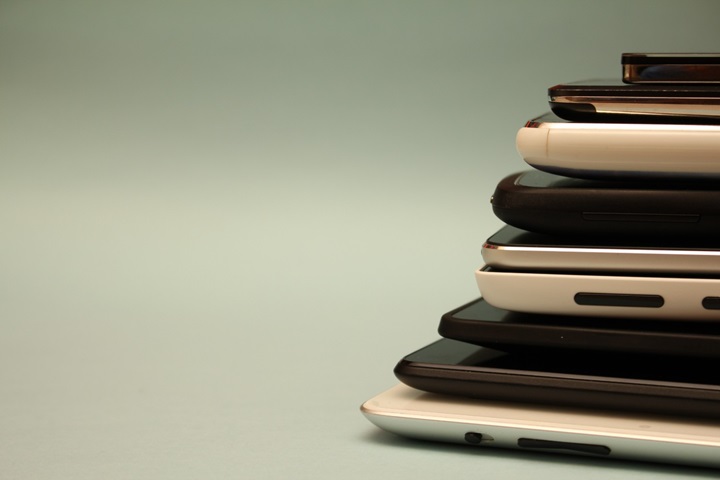Our smartphone OS data for the fourth quarter of 2021 reveals iOS share has grown year on year in the United States, China, France, and Germany. Android has achieved year-on-year share growth in Great Britain, but in all other reported markets OS share performance remains near flat.
The most popular smartphone models
In all reported markets, at least one model from the iPhone 13 series lineup falls within the top 3 models sold. In Australia, the iPhone 13 Pro Max and iPhone 13 Pro are the top 1 and 2 models sold, respectively. iPhone 13 is the number one model sold in the United States, Japan, and China.
In China, iPhone experienced its highest sales share in a Q4 period since 2017; achieving 26% sales share, up 9 percentage points year on year, restoring its position as the number one smartphone brand purchased in a Q4 ending period. The chip shortage continues to have a huge impact on Huawei sales in China: it plummeted to just 14% sales share in Q4 2021, down 19 percentage points year on year. Honor’s sales share is also down year on year, by 3 percentage points, and it captures 11% of sales this quarter.
The Samsung Galaxy A12 also proved a popular model across Europe this quarter, and was the top seller in France, Great Britain, and Italy. For Samsung’s latest flip and fold smartphone innovations, the Galaxy Z Fold3 5G and Galaxy Z Flip3 5G, model sales rankings were outside of the top 20 in the EU5 (France, Great Britain, Italy, Spain and Germany), Australia and the United States. Nevertheless, Samsung sales share overall was up or remained flat year on year across all reported markets, except Germany and France.
Favourite features
Zooming into the specific features that have led EU5 consumers to purchase models from the much-anticipated iPhone 13 series and Galaxy Z Fip3 5G launches, the differences are quite stark. Buyers of the iPhone 13 and iPhone 13 Pro lines were all purchasing for ‘Battery Life’, specifically the length of the battery life, and the ‘Quality of Camera’; both rank in the top 3 feature specific device drivers.
For the Galaxy Z Flip3 5G, ‘Attractiveness of the design’, ‘How it fits in my hand/pocket’, and ‘Quality/ Speed of the processor’ were cited as the top 3 device drivers. This demonstrates that Samsung’s latest smartphone innovation is driving the intended feature levers, but potentially still among a niche audience. Meanwhile, iPhone addresses some the biggest commoditised pain points among smartphone owners.
‘5G Capability’ continues to be cited as a device purchase driver by more consumers, growing in popularity by at least 3 percentage points year on year, across all reported markets (with the exception of China, where the feature was mentioned 4 percentage points less year on year, with 19% buyer citation). Nevertheless, intention to buy 5G devices continues to increase; in China, 93% of future smartphone buyers intend to buy a 5G device, this is 82% in the United States, 77% in Australia, 74% in EU5, and 64% in Japan.
How people buy smartphones
In Q4 2021, online smartphone sales have remained flat (or declined year on year) across all reported markets, except in China, Japan, United States and Germany, where online sales share growth is no more than 4 percentage points. Has smartphone ecommerce levelled out what looks to be post the height of the pandemic? Although it may look this way, online sales remain higher than prior to the pandemic.
Another trend we see is the growth of direct-to-consumer (D2C) sales. In Q4 2021, 1 in 5 iPhones sold in the EU5 were direct to the consumer, up 5 percentage points compared to Q4 2019. For Samsung, D2C sales share doubled to 6% vs. Q4 2019. In the United States, 27% of iPhones are sold D2C, up 5 percentage points vs. Q4 2019.
The impact of COVID-19
The average length of smartphone ownership continues to increase. This had been the case pre-COVID-19, but the pandemic has accelerated this trend. In the EU5, 26% of smartphone owners now hold a device that they’ve kept for 3 or more years, up 6 percentage points vs. Dec. 2019; this is 24% in the US, up 5 percentage points. This means the pool of potential buyers is building up, but they lay dormant.
This is important, as our advanced analytics shows us that the longer consumers are dormant for, the further their propensity to remain brand loyal decreases, and the risk of churn becomes greater, particularly among those who are passive. OEMs need to plan how to reintroduce, excite and engage their consumers when they are in the market to buy, after what may be an extended period away for many.
Access our data visualisation tool to view and analyse smartphone OS market share data online. The latest sales share figures for the major operators can be viewed and compared with historical figures, and all graphics within the Kantar dataviz are available to embed in your site.


